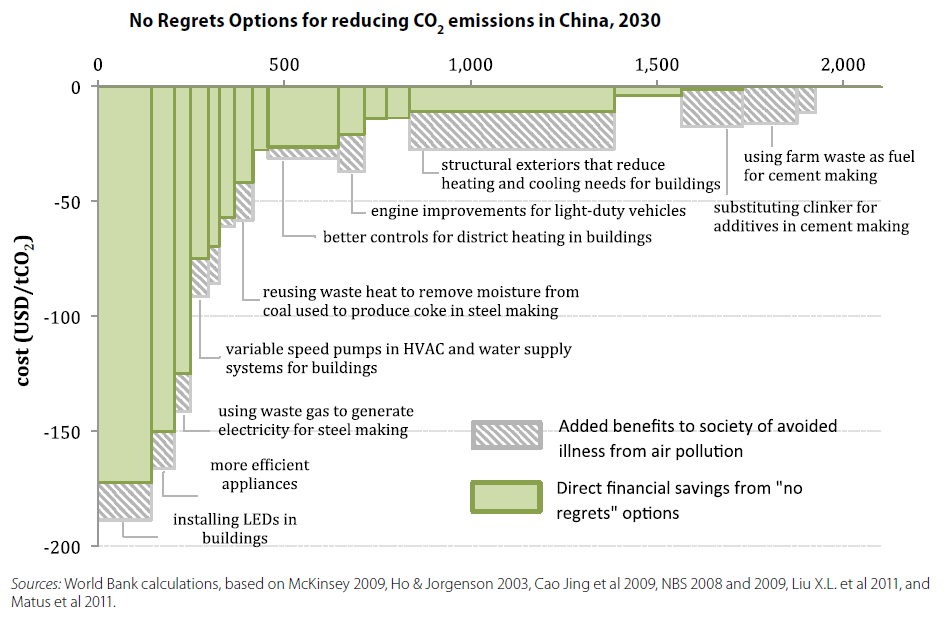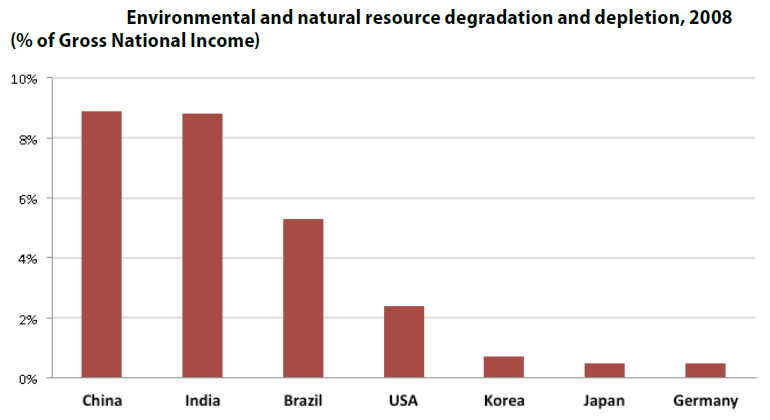Last month The World Bank has released a report titled “China 2030: Building a Modern, Harmonious, and Creative High Income Society.” Within are policy recommendations for the sustained economic growth of one of the world’s most dynamic nations. According to the World Bank—an international financial institution focused on developing countries—green development is key to China’s continued success with a greater role for the utilization of renewable energy.
In the short-term, the World Bank details gains that can be made through more efficient pricing systems, regulatory reform, and from green infrastructure investment. These improvements essentially pay for themselves.
Whereas some new green technologies cost, many other technology and management changes that can help narrow the gap between China and the high-income countries already pay for themselves through lowered energy and input costs. Policies and investments to improve efficiency, by increasing returns for investments in green technologies and products, will immediately add to growth. For example, according to estimates by McKinsey & Company, installing LEDs for lighting in buildings could generate USD 25 billion in financial savings per year by 2030 compared to business as usual (measured in 2009 USD). Improving passive heating and cooling in buildings through design modifications could provide another USD 6 billion. Industry is the largest sectoral user of energy, accounting for about 72 percent of primary energy demand in 2008, and many efficiency gains can be found there. All together, the potential for direct savings through efficiency gains in China could be as high as USD 65 billion per year by 2030, if the full technical and economic potential of these no-regret options can be realized.
…there are presently several hundred mature energy-saving technologies available to but not fully deployed by China’s high energy-consumption industries. The analysis shows that if energy-intensive industrial sectors applied widely, by 2020, 79 of these major technologies, the accumulated energy savings would be 456 million tce (with a corresponding reduction in CO2 emissions of 1.2 billion tCO2). If all existing and emerging energy efficiency technologies available for energy-intensive industrial sectors were applied by 2020, the accumulated energy savings capacity would be 650–750 million tce (with corresponding reductions in CO2 of 1.7–1.9 billion tCO2).
Then emphasized are the prospective benefits of domestic research and development in the medium-term. Of particular interest is the potential for innovation in China’s renewable energy industry, and the associated positive effects this will have throughout the rest of the nation’s economy.
The most concrete example of emerging industries are clean energy, and some such as solar power, wind power, biomass, and hydropower have already been commercialized on a large scale. China’s seven targeted strategic industries, as mentioned above, are environmental protection and energy efficiency, new energy, next generation information technology, biotechnology, high-end manufacturing, clean-energy vehicles, and high-tech materials. Globally, business opportunities in many of these sectors, including clean-energy vehicles and clean energy are shifting toward the developing countries.
Some of the greatest technological leaps are expected to come from solar and wind power, but natural endowments—combined with expanding energy demand—ensure prominent roles for hydropower and biomass.
Relentless cost reductions and technological progress in renewable energy technologies in China have exceeded expectations, mostly due to massive scaling-up of the industry. In renewable energy, the cost of both wind energy equipment and solar photovoltaic have decreased dramatically during the past 5 years. The wholesale prices of coal-fired and wind power are already very close (just under RMB 0.50 per kWh). In the case of solar PV, the price of unit modules has decreased from USD 23 per module in 1980 to less than USD 3 per module in 2010. Following this long-term trend, the existing gap between coal-fired and solar PV power will likely be closed by 2020. Similarly, the costs of biomass, marine power, shale gas, coal gasification, and other clean energies will continue to decrease.
The rapid progress of clean energy technologies is illustrated by the dramatic rise in the number of worldwide patent filings for wind power, solar PV, ocean energy, electric/hybrid vehicles, and lighting energy efficiency technologies. China occupies a prominent place within this global trend of innovation. The number of wind power patents granted to Chinese inventors, for example, has surged within the past 5–7 years, and transfers of wind power technologies to China from the developed countries over the past two decades have exceeded any other country. As China continues to absorb and innovate new green technologies—supported in part by government investment and policies—these technologies will become increasingly competitive and contribute to the country’s growth in the upcoming years.
Total exploitable renewable energy resources in China (TW)
| Wind power | 173.4 |
| Small-scale hydropower | 133.3 |
| Biomass | 25.4 |
| Solar PV | 22.7 |
| Total | 354.7 |
The increased usage of more environmentally friendly technologies along with an improved policy environment and heightened levels of green infrastructure should diminish an acute problem in China’s economy: excessive costs imposed by environmental degradation. This is particularly apparent in comparison to other countries.
In order to make the prescribed green China a reality by 2030, it will have to overcome such challenges as weak incentives for environmental protection, and weak monitoring and enforcement standards at the local level.
Will China’s economy inspire awe in the next generation as it did in the last? If so, per the World Bank’s advice, green development and renewable energy will be prerequisites to China’s next stage of modernization.


